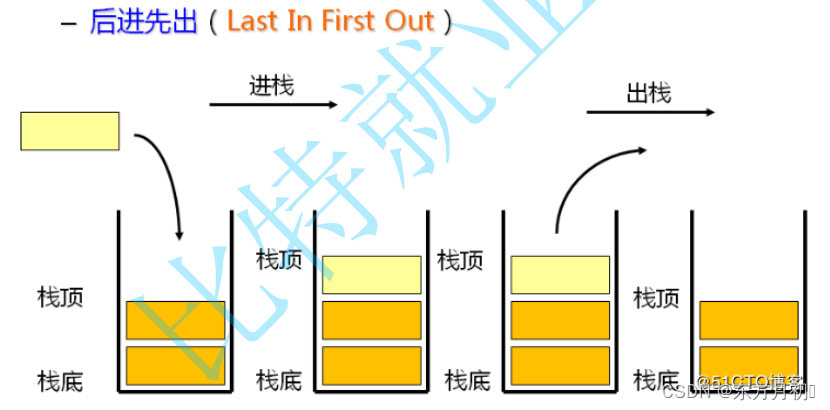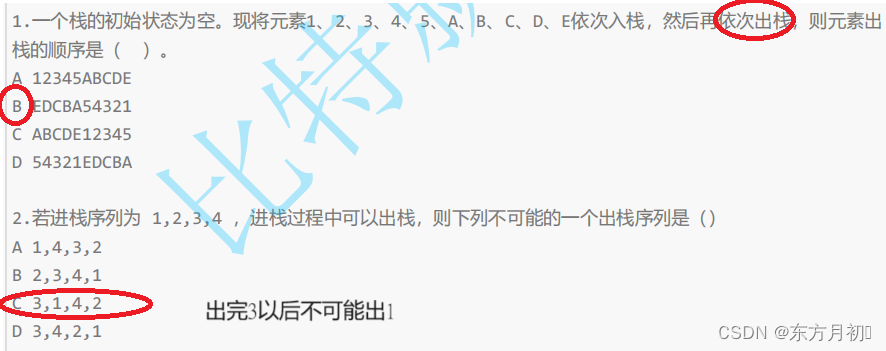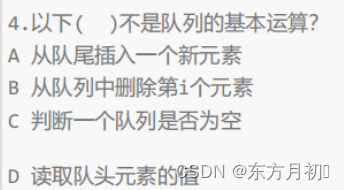一.栈
1.栈的概念和结构
栈:一种特殊的线性表,其只允许在固定的一端进行插入和删除元素操作。
进行数据插入和删除操作的一端
称为栈顶,另一端称为栈底。
栈中的数据元素遵守后进先出
LIFO
(
Last In First Out
)的原则。
压栈:栈的插入操作叫做进栈
/
压栈
/
入栈,
入数据在栈顶
。
出栈:栈的删除操作叫做出栈。
出数据也在栈顶
。

2.栈的相关习题

二.栈的接口实现
1.头文件
#pragma once
#include<stdio.h>
#include<stdlib.h>
#include<stdbool.h>
#include<assert.h>
typedef int STDataType;
typedef struct Stack
{
STDataType* a;
int top;
int capacity;
}ST;
void STInit(ST* ps);
void STDestroy(ST* ps);
void STPush(ST* ps, STDataType x);
void STPop(ST* ps);
int STSize(ST* ps);
bool STEmpty(ST* ps);
STDataType STTop(ST* ps);
2.初始化栈
void STInit(ST* ps)
{
assert(ps);
ps->a = (STDataType*)malloc(sizeof(STDataType) * 4);
if (ps->a == NULL)
{
perror("malloc fail");
return;
}
ps->capacity = 4;
ps->top = 0; // top是栈顶元素的下一个位置
//ps->top = -1; // top是栈顶元素位置
}3.销毁栈
其实本质上就是一个删除节点的过程。
void STDestroy(ST* ps)
{
assert(ps);
free(ps->a);
ps->a = NULL;
ps->top = 0;
ps->capacity = 0;
}4.入栈
void STPush(ST* ps, STDataType x)
{
assert(ps);
if (ps->top == ps->capacity)
{
STDataType* tmp = (STDataType*)realloc(ps->a,
sizeof(STDataType) * ps->capacity*2);
if (tmp == NULL)
{
perror("realloc fail");
return;
}
ps->a = tmp;
ps->capacity *= 2;
}
ps->a[ps->top] = x;
ps->top++;
}5.出栈
void STPop(ST* ps)
{
assert(ps);
assert(!STEmpty(ps));
ps->top--;
}栈的本质:顺序表
从出栈上就可以明显的看出栈选择用顺序表实现的理由,我们只需要对top的大小做出改变就可以实现出栈。
6.栈的数据个数
int STSize(ST* ps)
{
assert(ps);
return ps->top;
}7.判断是否为空栈
bool STEmpty(ST* ps)
{
assert(ps);
return ps->top == 0;
}8.输出栈顶元素
STDataType STTop(ST* ps)
{
assert(ps);
assert(!STEmpty(ps));
return ps->a[ps->top - 1];
}三.队列
1.队列的概念和结构

队列就是先进的先出。
2.队列的相关习题

队列删除只能删第一个,不能选择一个删除。
四.队列的接口实现
//Queue.h
#pragma once
#include<stdio.h>
#include<stdlib.h>
#include<stdbool.h>
#include<assert.h>
typedef char QDatatype;
typedef struct QueueNode
{
struct QueueNode* next;
QDatatype data;
}QNode;
typedef struct Queue
{
QNode* head;
QNode* tail;
int size;
}Queue;
void QueueInit(Queue* pq);
void QueueDestroy(Queue* pq);
void QueuePush(Queue* pq, QDatatype x);
void QueuePop(Queue* pq);
int QueueSize(Queue* pq);
bool QueueEmpty(Queue* pq);
QDatatype QueueFront(Queue* pq);
QDatatype QueueBack(Queue* pq);
//Queue.c
#include"Queue.h"
void QueueInit(Queue* pq)
{
assert(pq);
pq->head = pq->tail = NULL;
pq->size = 0;
}
void QueueDestroy(Queue* pq)
{
assert(pq);
QNode* cur = pq->head;
while (cur)
{
QNode* next = cur->next;
free(cur);
cur = next;
}
pq->head = pq->tail = NULL;
pq->size = 0;
}
void QueuePush(Queue* pq, QDatatype x)
{
QNode* newnode = (QNode*)malloc(sizeof(QNode));
if (newnode == NULL)
{
perror("malloc fail");
return;
}
newnode->data = x;
newnode->next = NULL;
if (pq->head == NULL)
{
assert(pq->tail == NULL);
pq->head = pq->tail = newnode;
}
else
{
pq->tail->next = newnode;
pq->tail = newnode;
}
pq->size++;
}
void QueuePop(Queue* pq)
{
assert(pq);
assert(pq->head != NULL);
/*QNode* next = pq->head->next;
free(pq->head);
pq->head = next;
if (pq->head == NULL)
pq->tail = NULL;*/
if (pq->head->next == NULL)
{
free(pq->head);
pq->head = pq->tail = NULL;
}
else
{
QNode* next = pq->head->next;
free(pq->head);
pq->head = next;
}
pq->size--;
}
int QueueSize(Queue* pq)
{
assert(pq);
return pq->size;
}
bool QueueEmpty(Queue* pq)
{
assert(pq);
return pq->size == 0;
}
QDatatype QueueFront(Queue* pq)
{
assert(pq);
assert(!QueueEmpty(pq));
return pq->head->data;
}
QDatatype QueueBack(Queue* pq)
{
assert(pq);
assert(!QueueEmpty(pq));
return pq->tail->data;
}





















 22万+
22万+











 被折叠的 条评论
为什么被折叠?
被折叠的 条评论
为什么被折叠?








